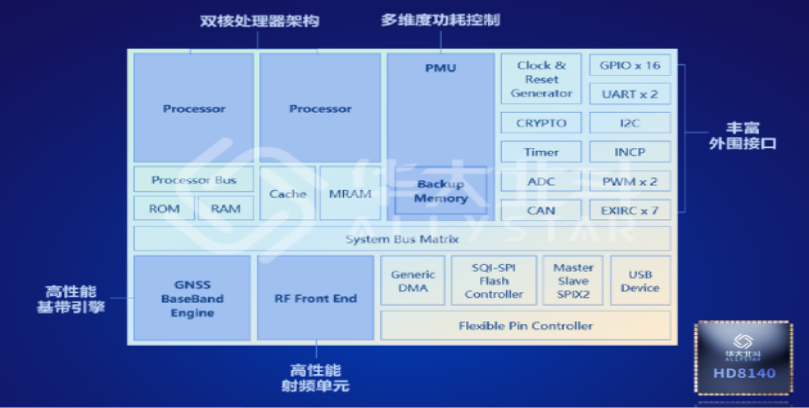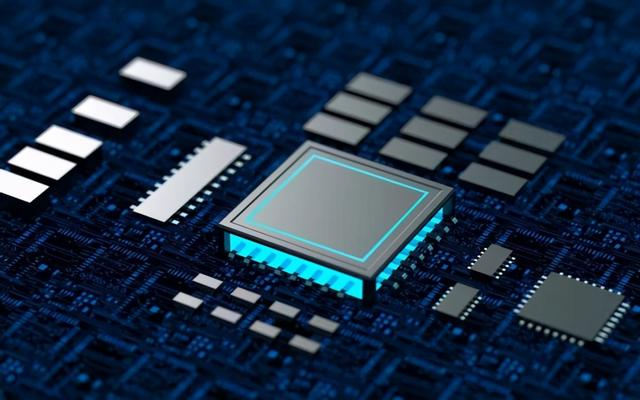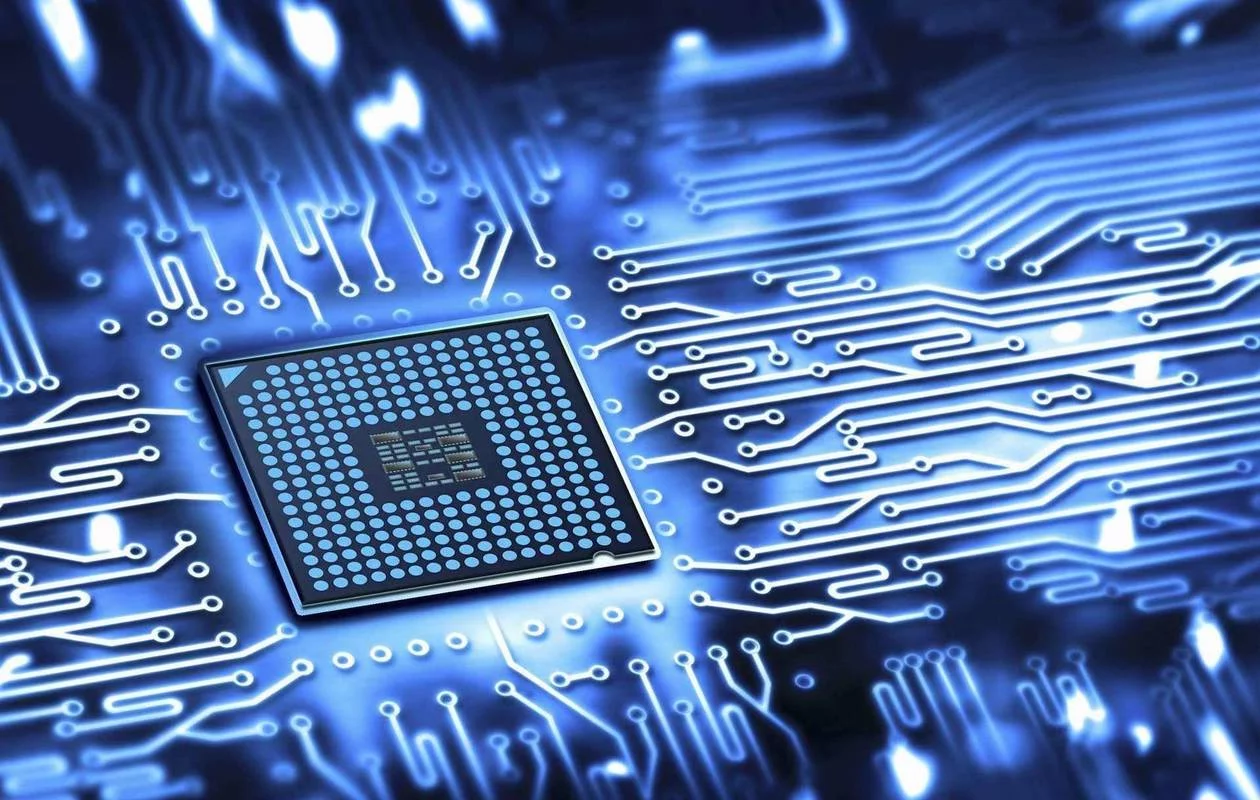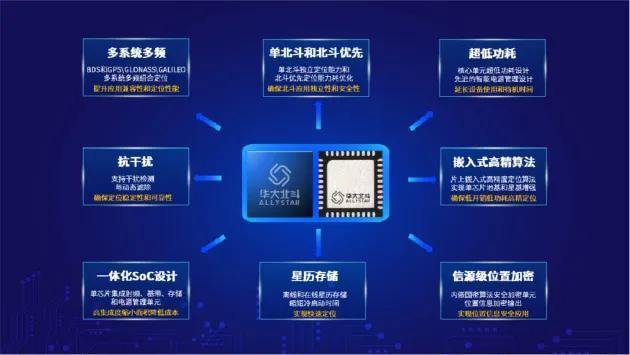Chips are the core and cornerstone of the information industry, serving as a crucial indicator of a country's comprehensive strength. Core chips not only bring substantial profits to the national information industry and economic development but also exert a multiplier effect through industrial driving forces, powerfully propelling the rapid development of the entire industry. BEIDOU chip plays a pivotal role in ensuring the security of China's spatiotemporal information and serves as a crucial pillar of the national science and technology innovation strategy. Only by relying on independent and controllable advanced BEIDOU chips can we get rid of the long-term technical barriers, monopoly and being subject to people by foreign manufacturers from the source of BEIDOU industrial chain, and thoroughly solve the challenges faced by BEIDOU application and space-time information security in China.
BEIDOU chip mainly includes GNSS RF receiver, GNSS baseband signal processor, microprocessor, power management, memory and control unit, memory, peripheral interface circuit and so on. Because of the complexity of chip design, especially the design complexity of RF and baseband integrated SoC chip is higher. The difference of design capability directly affects chip performance, sensitivity, power consumption, size, cost and other aspects, and then greatly affects the core competitiveness of navigation and positioning terminal products.
For a series of emerging intelligent industries, such as Internet of Things, Internet of Vehicles, intelligent driving, bike-sharing, intelligent transportation, intelligent infrastructure, intelligent logistics, etc., BEIDOU high-precision positioning and timing service provided by BEIDOU chip is an indispensable foundation for these applications. Only by building on the independent and controllable space-time information foundation can the application and development of various emerging intelligent industries be stable and safe. At present, on the latest fourth generation BEIDOU chip structure diagram released by ALLYSTAR, chip high integration design, performance enhancement design and multi-dimensional power consumption control design have become the focus of BEIDOU chip technology research and development.

Figure1: ALLYSTAR HD8140 chip
High Integration Design of SoC
SoC (System on Chip) chip is called System on Chip, also known as System on Chip, which contains all the contents of the complete hardware system and embedded software system of the chip, and is the main research direction of mainstream chip enterprises at present. SoC is also a design concept, which integrates various modules that can be integrated into one chip, including RF, baseband, power management, embedded storage, interface and other technologies. The introduction of SoC chips is in contrast to the past SIP chips (System in a Package, integrating multiple functional chips into one package to achieve a basic complete function) Because all the functions of SIP chips are realized by one chip, SoC chips have great advantages over SIP chips in size, power consumption and cost.
The fourth generation BEIDOU chip newly released by ALLYSTAR continues to adopt SoC chip architecture like its previous series chips. Two microprocessors, RF unit, digital baseband unit, memory, power management unit, peripheral interface, etc. are integrated on a single chip, which has the advantages of high integration, strong function, low power consumption and small size, and further improves the competitiveness of products. Its design difficulty lies in: through complex design, to avoid the mutual influence of each module, to ensure that each module can play the best performance when working together.
With the improvement of SoC highly integrated design technology, the size of domestic BEIDOU chip will be further reduced. With the reduction of the physical size of the chip, it also means that the physical cost of the chip drops synchronously, which will make the domestic BEIDOU chip participate in international competition and play a key basic supporting role in supporting the global large-scale application of BEIDOU system.

Figuer2
Performance enhancement design
Multi-system and multi-frequency combined positioning capability
Multi-system and multi-frequency integrated positioning technology requires that the chip should be compatible with BEIDOU (China), GPS (USA), GLONASS (Russia), GALILEO (Europe), QZSS (Japan) and NavIC (India), and at the same time, it should be able to receive and integrate satellite signals at L1, L2, L5 and L6 frequency points. So as to maximize the use of satellite signal resources and improve the positioning performance.
Single BEIDOU positioning and BEIDOU priority positioning capability
The chip should support the new generation B1I, B1C, B2I, B3I, B2a and B2b signals of BEIDOU-3, and better support the positioning time and positioning accuracy requirements of single BEIDOU. In the aspect of algorithm design, it is necessary to capture BEIDOU satellite first for positioning, and choose BEIDOU satellite system as the master system and other satellite systems as the slave system. And achieving the reliability and security of independent or priority operation of BEIDOU The latest fourth-generation BEIDOU chip released by ALLYSTAR also continues to strengthen its support for single BEIDOU positioning and BEIDOU priority positioning capabilities.
Anti-interference ability
BEIDOU chip will encounter various interference signals in its work, so it is necessary for the chip to detect the frequency of interference signals in real time and filter out the interference signals automatically, so as to avoid the influence of interference signals on the navigation and positioning function of the chip.
Embedded high-precision positioning algorithm capability
The implementation of embedded high-precision positioning algorithm on BEIDOU chip usually requires the processor to have high operation speed and large storage space. However, for BEIDOU chips in large-scale application, power consumption and cost limit the computing and storage resources that can be used to achieve high-precision algorithms, which is very difficult to realize. Under the limitation of limited chip memory capacity and processor operating frequency, the realization of chip-level embedded ground-based enhanced and satellite-based enhanced high-precision positioning algorithms puts forward more challenging requirements for the research and development of domestic BEIDOU chips. The fourth generation BEIDOU chip newly released by ALLYSTAR not only supports high-precision satellite positioning algorithm, but also supports integrated navigation and positioning algorithm of satellite and inertial navigation, which makes the chip more widely applicable scenarios and further improves positioning reliability.
Online ephemeris acquisition and offline ephemeris prediction capabilities
The ephemeris data of satellite is the basic data of navigation and positioning, but in the weak signal environment, the time for the chip to obtain navigation messages from satellite becomes longer, so the ephemeris storage function is needed, which can quickly provide the navigation satellite message information needed for positioning to the positioning chip, so that the chip can quickly obtain navigation message information when it is cold started next time, thus shortening the cold start time and achieving fast positioning. Online ephemeris acquisition technology and offline ephemeris prediction technology are the key to solve the above problems. This capability has always been one of the characteristics of ALLYSTAR chip.
"Source-level" security BEIDOU capability
The integration of BEIDOU navigation and positioning information is a key aspect of industry application information fusion. The authenticity and confidentiality of this information are prerequisites for the security and reliability of industry applications. Ensuring that information is not stolen or tampered with in the transmission link becomes a critical requirement for industry applications. Designing a hardware encryption unit in BEIDOU chip to realize "source-grade" location information encryption output will be the key to solve this hidden danger, and will provide the underlying security support for industrial applications based on location information.

Figure3
Multi-dimensional power consumption control design
The power consumption of BEIDOU chip directly affects the standby and service time of terminals, especially for mobile terminals mainly powered by batteries. In order to further reduce the power consumption of BEIDOU chip, BEIDOU chip needs to fully evaluate all design points that affect the power consumption in the design process, and minimize the power consumption of the chip through multi-dimensional optimization design. Taking the latest released fourth-generation BEIDOU chip from ALLYSTAR as an example, its adoption of multidimensional power control design has resulted in a significant optimization, with power consumption reduced by around 50% compared to the previous generation product
Optimal design of power consumption of RF circuit
The power consumption of chip RF receiver can be greatly reduced by adopting the RF architecture that only needs a low noise amplifier and a phase-locked loop to realize dual-band signal receiving at the same time. At the same time, the bandwidth and power of the receiver are dynamically configured according to the signals of different frequency bands in different systems, so as to achieve the best equalization of signal receiving quality and power consumption. Through the fine optimization design of structure and circuit, the overall power consumption of the receiver is minimized.
Very low standby power design
A thick gate oxide transistor with extremely low leakage power consumption is used to design the standby wake-up circuit, and a crystal oscillator circuit with extremely low power consumption is designed to ensure that the chip can wake up regularly in the standby state with extremely low power consumption. In the standby state, the overall standby power consumption of the chip is less than 2uA, which can achieve the standby power consumption performance of mainstream low-power MCU chips in the industry.
Dynamic frequency adjustment technology
The dynamic power consumption of the processor can be reduced linearly by dynamically adjusting the operating frequency and voltage of the processor according to the workload of the processor. When high performance is required, the digital clock frequency can be increased to give full play to the processor capacity. At this time, the dynamic voltage frequency adjustment circuit will automatically increase the operating voltage of the digital logic and memory to ensure that the digital logic circuit has sufficient operating speed. When there is no highly performance requirement, the digital clock can be reduced to save power consumption. At this time, the dynamic voltage and frequency adjustment circuit will automatically reduce the working voltage of digital logic and memory, thus further saving the power consumption of digital circuit.
Optimize power management strategy
In order to achieve the goal of lower power consumption, the chip can adopt multi-power domain design. Under different requirements, the chip can switch the power in different power domains and enter different power modes to achieve the purpose of reducing power consumption. According to the order of decreasing power consumption, the power supply modes of the chip can be divided into: System Run Mode, Sleep Mode, Deep Sleep Mode and Standby Mode.
Integrated Design of DC-DC Power Supply
The high-efficiency DC-DC (switching power supply) module is integrated in BEIDOU chip design to meet the high-efficiency power conversion under the condition of light and heavy load current. The built-in DC-DC converter not only saves the cost of peripheral components of the chip, but also makes it easier for the chip to control the switching power supply according to its own needs, thus achieving the purpose of reducing power consumption.

Figure4: functions of beidou chip
BEIDOU chip is a key link in the foundation of BEIDOU industry. The above-mentioned key core technologies are only a glimpse, and there are more key technologies that need to be broken through and upgraded by domestic BEIDOU chip manufacturers in order to strive for global market competitiveness. The innovative design methods of these technologies will play an important role in improving the function and performance of chips and reducing the cost.
Domestic BEIDOU GNSS satellite navigation and positioning chip enterprises, represented by ALLYSTAR, have always regarded the research and development of BEIDOU chip core technology as the top priority and the cornerstone of development. Faced with the threat of international technological monopoly and strangle, only through independent innovation can breakthroughs be achieved. This is the only way to secure a place for China's BEIDOU technology in the fiercely competitive global market. The "14th Five-Year Plan" has entered the second half, and BEIDOU scale application has also entered a critical stage of marketization, industrialization and internationalization. Only by mastering the key core technologies of chips, especially the leading technologies of high-end products, can China's information industry occupy the commanding heights of the industrial chain worldwide and further support the national strategy of China's information industry development.
A Solid Foundation for the Smart Industry: An Analysis of Key Technologies in BEIDOU Chips-China.exportsemi.com






